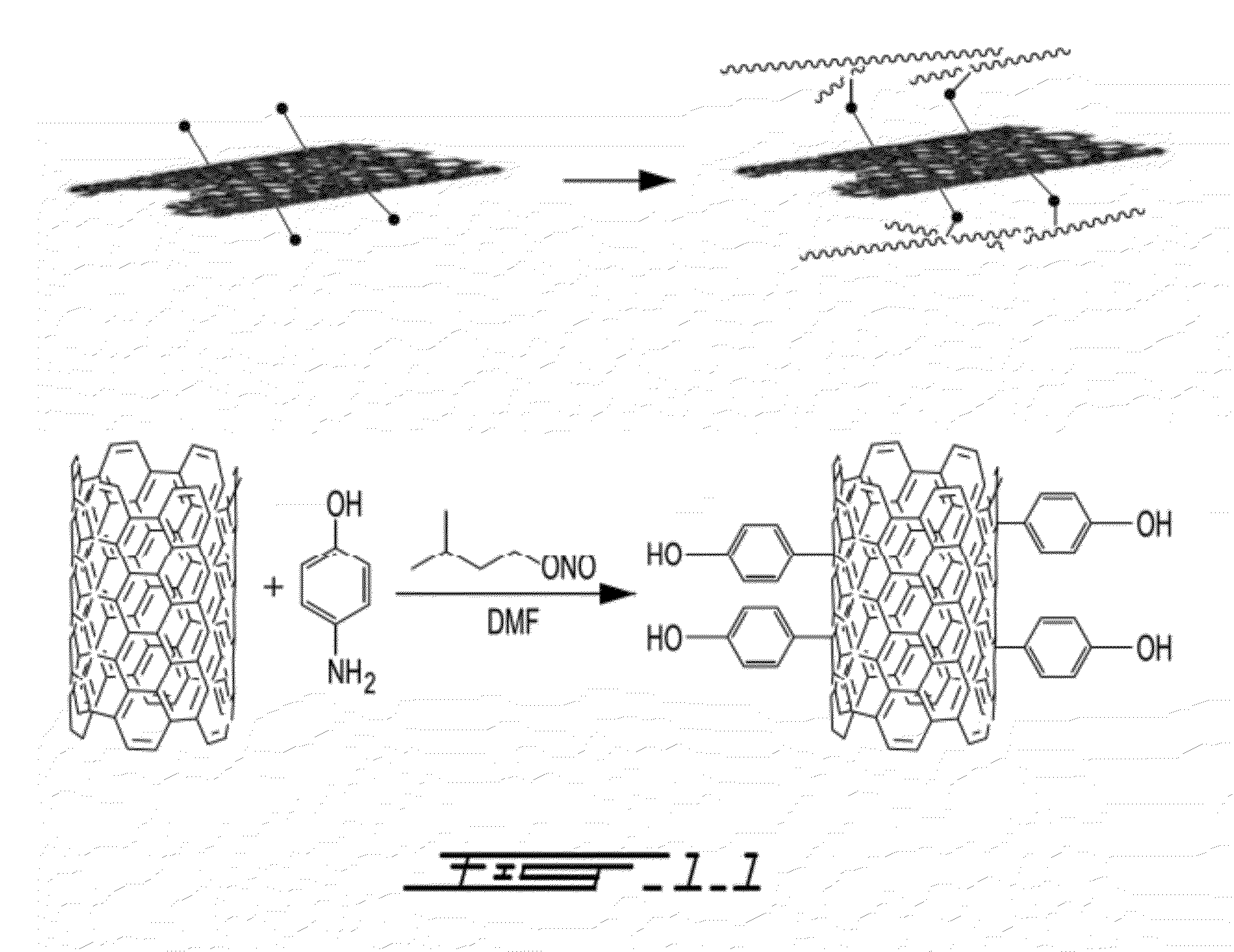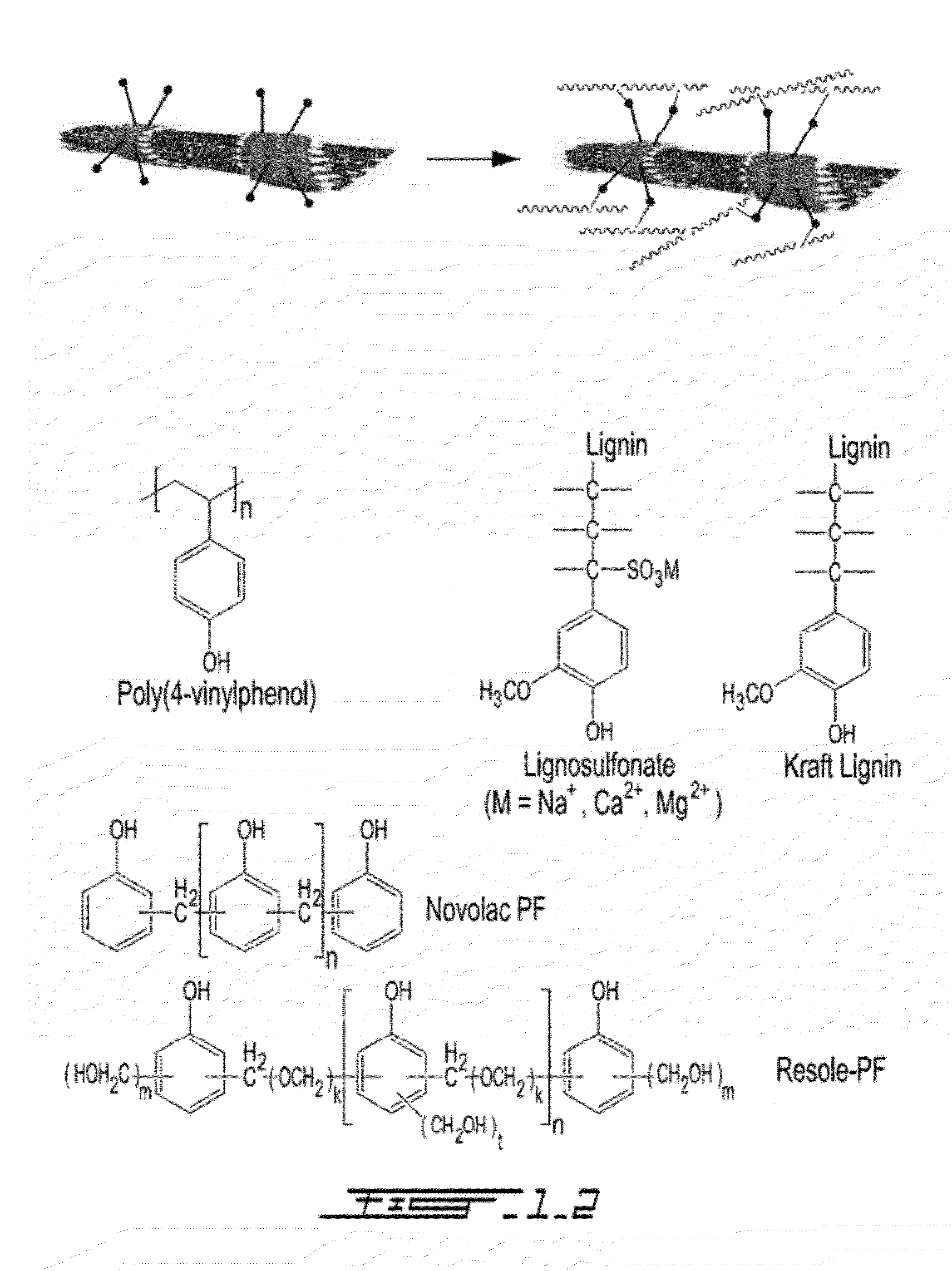Phenol-formaldehyde polymer with carbon nanotubes, a method of producing same, and products derived therefrom
a technology of carbon nanotubes and phenol-formaldehyde, which is applied in the direction of material nanotechnology, lignin adhesives, adhesive types, etc., can solve the problems of not significant progress in developing nanotube-based composites that outperform the best carbon-fiber composites, and the use of cnts/phenolic resin mixtures as structural composites
- Summary
- Abstract
- Description
- Claims
- Application Information
AI Technical Summary
Problems solved by technology
Method used
Image
Examples
example 1.1
Covalent Chemistry Method
[0064]Phenol functionalized CNTs were prepared by the covalent reaction of p-aminophenol with SWCNTs in DMF using in situ diazotization and coupling procedure according to a published protocol, Bahr, J. L, Tour. J. M., Highly Functionalized Carbon Nanotubes Using in Situ Generated Dizonium Compounds. Chem. Mater. 2001, 13, pages 3823-2824. (FIG. 1.1).
[0065]FIG. 1.1 illustrates in covalent functionalization of a CNT with the inclusion of phenol moieties into the CNT structure, which moities act as a point of connection for the PF polymer during the polymerization reaction in two similar ways. FIG. 1.1 is meant to be illustrative and does not represent the mass ratios of the CNT and PF.
[0066]The Raman spectrum shows an increase in the disorder band (D-band) when compared to the spectrum of pristine nanotubes, indicating a covalent functionalization. In addition, the UV-vis adsorption spectrum showed the disappearance of all van Hove singularities when compared...
example 1.2
Supramolecular Chemistry Method
[0067]Supramolecular method involves physical adsorption of molecules capable of π-stacking or van der Waals interactions with the aromatic and hydrophobic nanotube sidewalls. Unlike covalent sidewall functionalization, the supramolecular strategy preserves the electronic and structural integrity of CNTs, permitting their use in applications requiring high conductivity and strength properties. This method is also simple, rapid, highly efficient, as well as cost effective. This method involves only sonicating the mixture of polymer(s) and CNTs in solvents.
[0068]FIG. 1.2 illustrates the supramolecular interactions of phenolic functional polymers, as well as the groups of three phenolic functional polymers that are applicable to the present polymerization. FIG. 1.2 is meant to be illustrative and does not represent the mass ratios of the CNT and PF in the polymer. Three types of phenolic functional polymers were found to form strong supramolecular interac...
example 1.3
Combination of Covalent and Supramolecular Chemistry Method
[0070]The advantage of covalent chemistry is that the covalent grafting of phenol functionalities can provide direct interfacial chemical bonding between CNTs and PF resin matrix, while the disadvantage is that the phenol functionalized CNTs have very poor solubility in NaOH aqueous solution, which limit their integration into LPF resins at the molecular level. By contrast, the high solubility of phenolic polymer-CNT complexes, due to the supramolecular chemistry, allow for an excellent integration of CNTs into LPF resins at the molecular level, and the phenolic functionalities on the CNTs surface help the cross-linking of the whole LPF system. However, the CNTs are still relatively loose in the LPF matrix because there is no direct interfacial chemical bonding between the CNTs and the matrix. Therefore the third method, which is a combination of covalent and supramolecular chemistry, was developed. In this method, CNTs were...
PUM
| Property | Measurement | Unit |
|---|---|---|
| elastic modulus | aaaaa | aaaaa |
| molar ratio | aaaaa | aaaaa |
| molar ratio | aaaaa | aaaaa |
Abstract
Description
Claims
Application Information
 Login to View More
Login to View More - R&D
- Intellectual Property
- Life Sciences
- Materials
- Tech Scout
- Unparalleled Data Quality
- Higher Quality Content
- 60% Fewer Hallucinations
Browse by: Latest US Patents, China's latest patents, Technical Efficacy Thesaurus, Application Domain, Technology Topic, Popular Technical Reports.
© 2025 PatSnap. All rights reserved.Legal|Privacy policy|Modern Slavery Act Transparency Statement|Sitemap|About US| Contact US: help@patsnap.com



